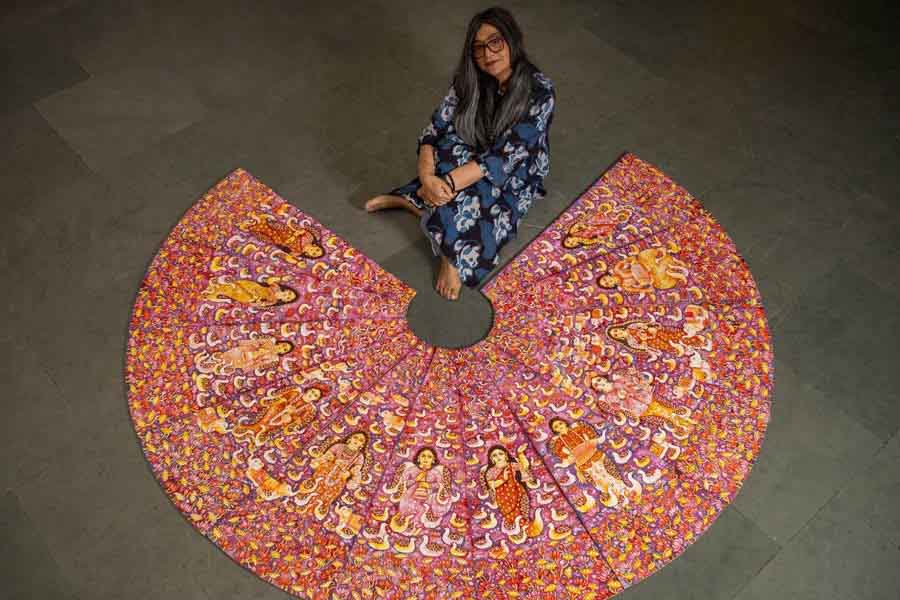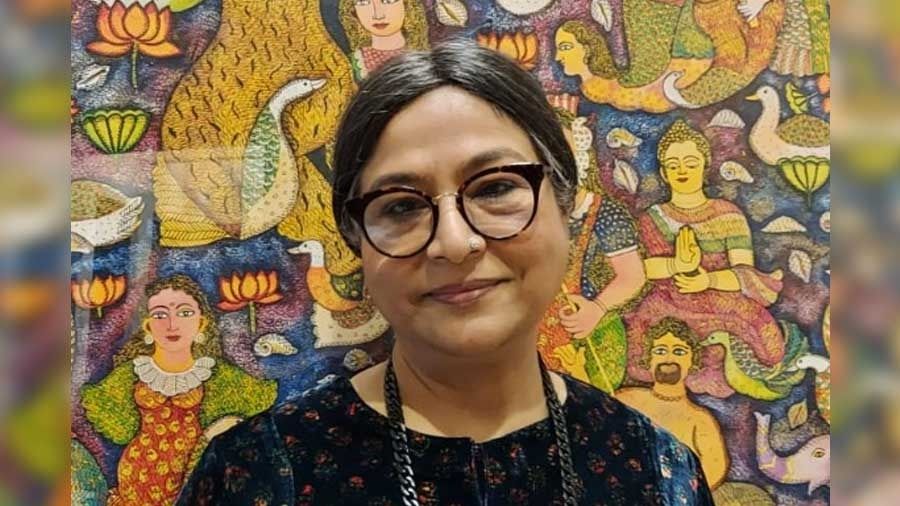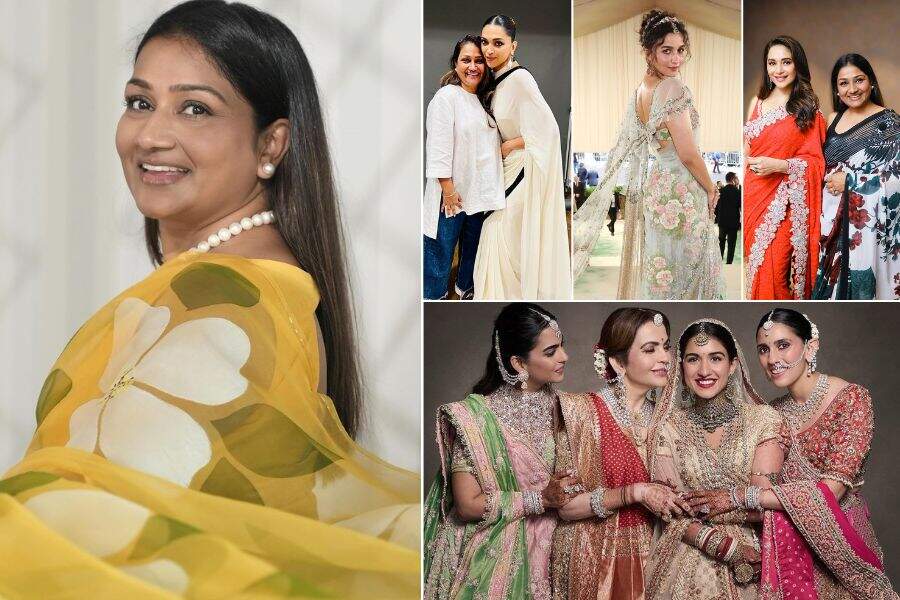With countless exhibitions and awards, including a National Award, to her name, 64-year-old Jayasri Burman is a veteran in the national and international art world. However, a surprise Zoom call and an earnest request suddenly made this celebrated painter and sculptor a household name.
The internet was suddenly abuzz with curious questions about the Delhi-based Bengali artist. And it all started when a resplendent Radhika Merchant walked into her Subh Aashirwad ceremony wearing a stunning piece of ‘art couture’ — Burman’s painstakingly hand-painted canvas-turned-lehenga.
Read on as Burman chats with My Kolkata about her Ambani connect, working in the fashion industry, what inspires her, and how Bengal has played a pivotal role in shaping her.
My Kolkata: Your hand-painted lehenga has been a resounding success! Tell us about the project and how much effort went into it.
Jayasri Burman: As with any other project, the thought process is very crucial. My work was a miniature painting on a long Italian canvas. Although challenging, I was happy because I was creating something beautiful for a positive reason.
The process was lengthy yet exciting. Since the canvas had to go to Abu Jani and Sandeep Khosla’s factory in Mumbai for stitching, I had less than a month to finish it. I ended up working 16 hours every day. Otherwise, it would’ve been impossible to complete.
‘If you wear my canvas as a piece of art, I will do it’
Can you tell us how the Ambani family got in touch with you?
I received a phone call about someone wanting to speak to me from their museum. To my surprise, when I joined the Zoom call, I saw Abu Jani, Sandeep Khosla, and Rhea Kapoor. “Jayasri, we have a request,” they said. “Can you do a lehenga? It will be a piece of art.” I immediately refused as there wasn’t enough time till the wedding.
Suddenly, Radhika joined the call and addressed me with great reverence. She melted my heart and I said, “Okay. If you wear my canvas as a piece of art, I will do it.” She immediately agreed. That’s how it all started.
What was Radhika Merchant’s reaction when she saw the lehenga?
Radhika was mesmerised by it. “Jayasri auntie, I want to wear this on the first day,” she gushed. But since they have a tradition of brides wearing a certain colour on the wedding day, she promised to wear it on another “special day”. And she kept her word.
We all saw how easily she walked around wearing my canvas, as it was lighter than other heavily sequined lehengas. With a lotus in her hair, she looked like my naika – the woman featured in my paintings.
On a broader note, how was your experience of working in the fashion industry?
I didn’t feel any difference from what I usually do. When I painted the canvas, it was like working on my other paintings, albeit in miniature form. I placed the lehenga’s canvas on a hard, wooden cut-out, which felt like the structure of my canvas. It never seemed like I was doing something separately for fashion. Art and fashion always go together.
‘When I look at women, I sense a strong hidden power in them’

Burman frequently takes inspiration from female characters in mythology, with Draupadi being one of her favourites
Your work is deeply rooted in mythology — from Draupadi to Ganesh Janani. What inspires you to pick such subjects?
Bengal inspires me. I am a Bengali girl born and brought up in Kolkata. I grew up seeing Durga Puja. Bengalis worship their mother-goddesses. Not only Durga, but also Lakshmi, Saraswati and Kali. I took inspiration from those beautiful, big idols.
When I look at women, I sense a strong hidden power in them. Otherwise, how can they carry a baby for almost 10 months and give birth? How can they make the kind of sacrifices they do? Take Draupadi, for instance. When I did the Draupadi show, I only read about Draupadi and thought about Draupadi for three years. I realised that she is a symbol of Maha Lakshmi, Maha Kali and Maha Saraswati. She is one of my favourite characters.
How did your journey as an artist begin? Who inspired you to pursue this path?
Although my creative mind was nurtured by my father, I can never say that somebody pushed me to be an artist. When I was young, baba used to sit with me every Sunday and recite Tagore’s poems. So, I started with writing poetry and then veered into art. You can say that the universe decided that I had to become an artist. My mind and soul motivated me to paint.
How did your family react when you decided to study art? And how did your experience at Kala Bhavan mould you?
My mother made every effort to encourage me to pursue further studies. However, she soon understood that I wouldn’t. Without painting, I don’t feel that I am here. My life is painting. My life is art. I can’t live without it.
As for my two years at Kala Bhavan — they gave me 20 years of journey. On my first day, my teacher, Shanad Kar, came to the class and brought a flower vase. He said, “Look at the vase and try to make a beautiful story out of it.” That is the beauty of Santiniketan, they teach students to imagine.
When I was there, I even met legends such as Sarbari Roy Choudhury, Dinkar Kowshik, K.G. Subramanyan and Ramkinkar Baij.
‘Jahnavi holds a little girl — telling us to nurture the universe’
If you had to choose one work you are most proud of, which one would it be?
I did a 22-foot bronze sculpture — Jahnavi (part of the River of Faith series). It is another name for Ganga. I’m delighted I could accomplish it because creating such a large sculpture was challenging. I worked on it during Covid. Witnessing dead bodies floating down the Ganga and how she’d wash them away, made me think of Jahnavi’s strength. In my sculpture, Jahnavi holds a little girl — telling us to nurture the universe. The little girl is the universe. The pandemic happened because we didn’t take care of the universe.
Between paintings and sculptures, which medium is closer to your heart and why?
If you are a mother to two children, you will love them equally. So, painting and sculpting are both important to me. I am more comfortable with painting because I know it’s in my hands, whereas I have to hire four or five people while working on a sculpture. However, a pen or pencil is the best because I can express myself with one stroke even during my travels.
As a female artist, what challenges did you face while establishing yourself?
In any profession, if a woman wants to be successful, she has to work 10 times more than a man. We have many roles to perform and are passionately involved in everything. But it makes us go through a lot of emotional discomfort and self-inflicted stress.
My life’s not been easy either. I have gone through many ups and downs. With each down, I thought I had to get up. And I did. We (women) have that extra shakti.
‘When I started, I never thought of earning money from art’

“Be an artist, don’t be a businessperson” is Burman’s advice to budding artists
Who is your favourite contemporary Indian artist?
I’m extremely fond of Ganesh Haloi, my godfather, who does abstract work. Jogen Chowdhury is fantastic as well. Among the contemporary artists, I love Anju Dodia’s work. I must also mention Subodh Gupta and Bharti Kher because they have made India proud.
AI has been a trending topic lately. Illustrators and graphic designers are nervous about how it will affect them. What is your take?
What is happening is horrifying. But nobody can beat the human touch. If we can continue it, our art will always remain. But, since people are getting used to AI easily, it will affect us.
Lastly, what is your advice for young artists who have just started their journey?
Be an artist. Don’t be a businessperson. Devote yourself with a pure heart, don’t think of how much you will sell your paintings for. Today, you might think I say this because I am successful. But when I started, I never thought of earning money from art.


